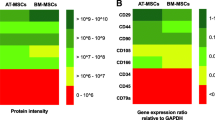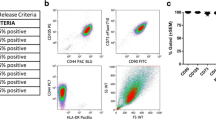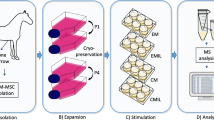Abstract
Osteoarthritis (OA) is considered the most prevalent form of arthritis. The aim of this study was to verify potential protein OA biomarkers by applying Selected Reaction Monitoring (SRM) assays to protein extracts obtained from Bone Marrow-Mesenchymal Stem Cells (BM-MSCs) isolated from OA patients.
BM aspirates were obtained from the femoral channel of OA patients at the time of surgery and from the femoral channel of hip fracture subjects without OA during hip joint replacement surgery for the treatment of subcapital fracture.
SRM results verified the differential expression of several protein biomarkers in BM-MSCs from OA patients.
Similar content being viewed by others
Proteomic approaches have proposed numerous protein factors potentially involved in pathological processes including osteoarthritis (OA) [1], the most prevalent rheumatic disease [2]. While the validation of such potential biomarkers has traditionally relied on immunoassays, specific antibodies may not be available [3], and selected reaction monitoring (SRM) has recently emerged as a promising application in medical screening due to its ability for multiplexed, high-throughput analysis as well as its sensitivity and quantitation capacity [4, 5]. In a previous work we have described the regulation of several proteins in bone marrow mesenchymal stem cells (BM-MSCs) from OA patients [6]. The potential application of MSCs in cell therapies aimed at rheumatic diseases has aroused great interest [7], and our results suggested the preactivation of these cells by signaling events produced by the subchondral bone. To verify these potential protein OA biomarkers, SRM assays have now been applied to protein extracts from BM-MSCs isolated from OA patients.
BM aspirates were obtained from two OA patients (age: 52 and 89 years) and three hip fracture subjects without OA (mean age 73.3 years, range 47–90) during hip joint replacement surgery. Hip fracture subjects without OA had a densitometric T-score > 2.5 SD (Hologic QDR-4500C) performed after surgery. All samples were obtained after patients gave their informed consent, and this study was approved by the local institutional ethics committee. After culturing the cell-containing fraction of BM aspirates as previously described [6], five pellets of approximately 2 × 106 confluent cells at the third passage were obtained. Then the cells were lysed, protein concentration was measured as previously described [6] and the five resulting protein extracts (110 μg each) were separated by SDS-PAGE on a 12% polyacrylamide gel. The proteins were stained and digested with trypsin as described in [6].
Since peptide precursor and fragment data from our previous, DIGE-based experiments [6] were generated using MALDI ionization, additional data based on ESI were necessary to choose the most appropriate transition pairs. For that, prior to SRM half the sample amount (55 μg) was subject to shotgun analysis on an LTQ-Orbitrap XL ETD (Thermo-Fisher) ESI mass spectrometer as described previously [8]. The precursor-diagnostic transitions to be assayed by SRM were chosen by carefully examining the MS/MS spectra corresponding to the peptides most reliably identified in the shotgun analysis (data not shown). To keep the transition list at a size that would not compromise the performance of the mass spectrometer, two to three transition pairs were chosen for eight out of the 38 proteins previously found regulated in the MSCs from OA patients [6]. A 4000 Q-Trap (AB Sciex) hybrid instrument was used for the multiplexed, non-time-scheduled SRM analysis of the above selected pairs followed by enhanced resolution scans (for charge and mass determination) and enhanced product ion scans (for induced fragmentation) along a single chromatographic run (80 min) per sample (55 μg). The analysis of mass spectra was carried out using the Analyst 1.5 software (AB Sciex). Relative peptide quantification was performed by measuring the area of the extracted ion chromatogram (XIC) peaks from selected precursor ions. Two transitions from pyruvate kinase peptides that showed comparable spectral counts across the two OA and the three control samples in the shotgun analysis were used to normalize XIC areas and to check that retention time variability was within ±2.5 min. In addition, the presence of the MS/MS fragmentation spectra from the corresponding precursor ions was manually checked along the XIC peaks to rule out interference from unrelated ions. The statistical comparison of the OA and control groups was performed based on parametric Student’s t test and/or non-parametric Mann–Whitney U test. Values with p < 0.05 were considered significant.
SRM results enabled the verification of a five-protein set for which significant differences were measured between patients and controls (Table 1 and Figure 1). The ratios calculated on the basis of the transition areas shown in the corresponding XIC and box and whisker plots (Figure 1) were comparable to those obtained by DIGE (Table 1). Limitations of this study have arisen from the reduced number of samples and cells available; thus, time-scheduled assays would have enabled SRM analysis of a much higher number of transition pairs, therefore expanding verification to other proteins. The availability of higher sample amounts would also enable: i) The analysis of technical replicates to improve statistical power; ii) The use of retention time standards or reference synthetic peptides to control chromatographic reproducibility; and iii) To minimize the use of precursor peptides with sub-optimal proteotypic nature by increasing sequence coverage in shotgun experiments
SRM assays with proteins previously found regulated in MSCs from osteoarthritic patients. For the measurements which produced significant differences (p < 0.05) between patients ( ) and controls (
) and controls ( ) the extracted ion chromatogram (XIC) is shown together with maximum, minimum and average ± SD values obtained by measuring peak areas corresponding to the transitions detailed in Table 1(a-i). Two transitions from pyruvate kinase peptides (GDLGIEIPAEK: 571.3(+2)/686.4(y6); IYVDDGLISLQVK: 731.9(+2)/574.4(y5)) were used to normalize the data. ct, controls; MSCs, mesenchymal stem cells; oa, osteoarthritis; SD, standard deviation.
) the extracted ion chromatogram (XIC) is shown together with maximum, minimum and average ± SD values obtained by measuring peak areas corresponding to the transitions detailed in Table 1(a-i). Two transitions from pyruvate kinase peptides (GDLGIEIPAEK: 571.3(+2)/686.4(y6); IYVDDGLISLQVK: 731.9(+2)/574.4(y5)) were used to normalize the data. ct, controls; MSCs, mesenchymal stem cells; oa, osteoarthritis; SD, standard deviation.
Based on SRM we have verified the differential expression of potential protein biomarkers in BM-MSCs from OA patients. Results reinforce the hypothesized preactivation of these cells by signaling events produced by the subchondral bone and corroborate the feasibility of using SRM for the quantitation of biomarker sets in clinically relevant samples.
Abbreviations
- BM:
-
Bone marrow
- DIGE:
-
Differential in-gel electrophoresis
- ESI:
-
Electrospray ionization
- MALDI:
-
Matrix-assisted laser desorption/ionization
- MSC:
-
Mesenchymal stem cell
- MS/MS:
-
Tandem mass spectrometry
- OA:
-
Osteoarthritis
- SDS-PAGE:
-
Sodium dodecylsulfate polyacrylamide gel electrophoresis
- SRM:
-
Selected reaction monitoring
- XIC:
-
Extracted ion chromatogram.
References
Camafeita E, Lamas JR, Calvo E, López JA, Fernández-Gutiérrez B: Proteomics: new insights into rheumatic diseases. Proteomics Clin App. 2009, 3: 226-241. 10.1002/prca.200800146
Lawrence RC, Felson DT, Helmick CG, Arnold LM, Choi H, Deyo RA, Gabriel S, Hirsch R, Hochberg MC, Hunder GG, Jordan JM, Katz JN, Kremers HM, Wolfe F, : Estimates of the prevalence of arthritis and other rheumatic conditions in the United States. Part II. Arthritis Rheum. 2008, 58: 26-35. 10.1002/art.23176
Addona TA, Abbatiello SE, Schilling B, Skates SJ, Mani DR, Bunk DM, Spiegelman CH, Zimmerman LJ, Ham AJ, Keshishian H, Hall SC, Allen S, Blackman RK, Borchers CH, Buck C, Cardasis HL, Cusack MP, Dodder NG, Gibson BW, Held JM, Hiltke T, Jackson A, Johansen EB, Kinsinger CR, Li J, Mesri M, Neubert TA, Niles RK, Pulsipher TC, Ransohoff D: Multi-site assessment of the precision and reproducibility of multiple reaction monitoring-based measurements of proteins in plasma. Nat Biotechnol. 2009, 27: 633-641. doi:10.1038/nbt.1546. Epub 2009 Jun 28. Erratum in: Nat Biotechnol. 2009 Sep;27(9):864,
James A, Jorgensen C: Basic design of MRM assays for peptide quantification. Methods Mol Biol. 2010, 658: 167-185. 10.1007/978-1-60761-780-8_10
Deutsch EW, Lam H, Aebersold R: PeptideAtlas: a resource for target selection for emerging targeted proteomics workflows. EMBO Rep. 2008, 9: 429-434. 10.1038/embor.2008.56
Rollín R, Marco F, Camafeita E, Calvo E, López-Durán L, Jover JA, López JA, Fernández-Gutiérrez B: Differential proteome of bone marrow mesenchymal stem cells from osteoarthritis patients. Osteoarthritis Cartilage. 2008, 16: 929-935. 10.1016/j.joca.2007.12.006
Djouad F, Bouffi C, Ghannam S, Noël D, Jorgensen C: Mesenchymal stem cells: innovative therapeutic tools for rheumatic diseases. Nat Rev Rheumatol. 2009, 5: 392-399. 10.1038/nrrheum.2009.104
Balsa E, Marco R, Perales-Clemente E, Szklarczyk R, Calvo E, Landázuri MO, Enríquez JA: NDUFA4 is a subunit of complex IV of the mammalian electron transport chain. Cell Metabolism. 2012, 16: 378-386. 10.1016/j.cmet.2012.07.015
Acknowledgements
The authors wish to thank the Orthopaedic surgeons from the Hospital Clínico San Carlos for providing BM samples.
Author information
Authors and Affiliations
Corresponding author
Additional information
Competing interests
The authors have no conflicts of interest to declare.
CNIC is supported by the Ministerio de Economía y Competitividad and the Fundación Pro CNIC. Support was also provided by FIS PI10/00178 and RETICS Program, RD08/0075 (RIER) from Instituto de Salud Carlos III (ISCIII). JRL is a recipient of Miguel Servet Program from Instituto de Salud Carlos III (ISCIII).
Authors’ contribution
EmC: SRM performing, writing of the manuscript and discussion of results. JRL: obtaining of mesenchymal stem cells and discussion of results. EC: SRM performing and discussion of results. PTE: obtaining of mesenchymal stem cells and discussion of results. JAL: SRM performing and discussion of results. BFG: selection of patients, writing of the manuscript and discussion of results. All authors read and approved the final manuscript.
Authors’ original submitted files for images
Below are the links to the authors’ original submitted files for images.
Rights and permissions
This article is published under an open access license. Please check the 'Copyright Information' section either on this page or in the PDF for details of this license and what re-use is permitted. If your intended use exceeds what is permitted by the license or if you are unable to locate the licence and re-use information, please contact the Rights and Permissions team.
About this article
Cite this article
Camafeita, E., Lamas, JR., Calvo, E. et al. Selected reaction monitoring assays in mesenchymal stem cells from osteoarthritis patients. Clin Proteom 11, 33 (2014). https://doi.org/10.1186/1559-0275-11-33
Received:
Accepted:
Published:
DOI: https://doi.org/10.1186/1559-0275-11-33





